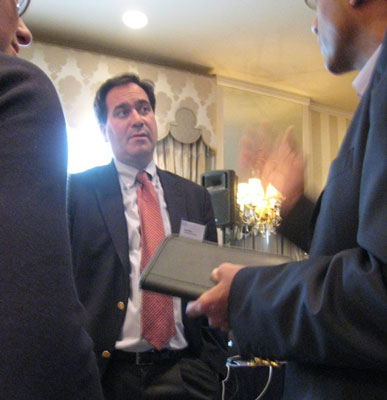| Posted: October 30, 2009 |
Symposium highlights nanotechnology's giant leaps |
|
(Nanowerk News) The advances made in nanotechnology, particularly with respect to the biological and medical fields, are a testament to the herculean leaps made in nanotechnology in a short period of time, according to medical experts.
|
|
In a presentation made Thursday at the International Institute for Nanotechnology’s (IIT) symposium, which was held in Evanston, University of Massachusetts-Amherst professor Vincent Rotello, noted that 20 years ago, “[nanoparticles and nanomaterials] really weren’t considered to be a separate state of matter.”
|
 |
| Chad Mirkin, nanotechnologist and director of the International Institute of Nanotechnolgy, takes a break from the symposium to chat with attendes. (Image: Marita Vera, MEDILL)
|
|
The work highlighted at the symposium concerns “things that are not only high-in-the-sky opportunities, but things that are now in the clinic and going through the early phases of testing,” said Chad Mirkin, a formidable figure in the nanotechnology field who is the director of IIT. Mirkin added that these nanotechnology advances “look like they are going to be promising new diagnostics for patient care.”
|
|
Humans have already benefitted from the discoveries made in nanotechnology, Rotello said.
|
|
This is why universities have backed nanotechnology research. Additionally, in the past decade, venture capitalists have jumped on board making sizeable investments in the biomedical and nanotechnology fields.
|
|
Mirkin believes venture capital funding is “critical” to nanotechnology. “It’s the step towards taking things that are academically promising to things that are commercially viable,” he said. “Venture capital in the U.S. in particular has been the third corner of the triangle required to take early discoveries to commercialization.”
|
|
Pre-eminent nanotechnology investor Steve Jurvetson, managing director at Draper Fisher Jurvetson, based in Menlo Park, Calif., agreed that venture capital investment – both funding and business mentorship - “is an important transition” in the full development of nanotechnology advances.
|
|
|
|
However, Jurvetson also noted the importance of government funding of nanotechnology, which he feels is best done in university laboratories.
|
|
In order for the work presented at this year’s symposium to reach its end market – patients – the commitment of the researchers must be matched by monetary funding of private and public investment, Mirkin said
|
|
This is why “a critical part of the Obama administration is that they support science at an almost unprecedented level,” added Mirkin, who is a member of President Obama’s Science and Technology Advisory Council. “New science leads to new technology.”
|

